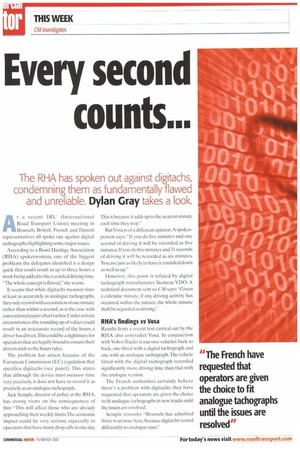Every second counts...
Page 30

Page 31

If you've noticed an error in this article please click here to report it so we can fix it.
The RHA has spoken out against digitachs, condemning them as fundamentally flawed and unreliable. Dylan Gray takes a look.
At a recent IRU (International Road Transport Union) meeting in Brussels, British, French and Danish representatives all spoke out against digital tachographs, highlighting some major issues.
According to a Road Haulage Association (RNA) spokeswoman, one of the biggest problems the delegates identified is a design quirk that could result in up to three hours a week being added to the recorded driving time. "The whole concept is flawed,"she warns.
It seems that while digitachs measure time at least as accurately as analogue tachographs, they only record with a resolution of one minute rather than within a second, as is the case with conventional paper-chart tachos. Under certain circumstances this rounding up of values could result in an inaccurate record of the hours a driver has driven.This could be a nightmare for operators that are legally bound to ensure their drivers stick to the hours rules.
The problem has arisen because of the European Commission (EC) regulation that specifies digitachs (see panel). This states that although the device must measure time very precisely, it does not have to record it as precisely as an analogue tachograph.
Jack Semple. director of policy at the RHA, has strong views on the consequences of this: "This will affect those who are already approaching their weekly limits.The economic impact could be very serious, especially to operators that have many drop-offs in one day. This is because it adds up to the nearest minute each time they stop."
But Vosa is of a different opinion. A spokesperson says: "If you do five minutes and one second of driving it will be recorded as five minutes. If you do five minutes and 31 seconds of driving it will be recorded as six minutes. You are just as likely to have it rounded down as well as up."
I lowever, this point is refuted by digital tachograph manufacturer Siemens VDO. A technical document sent to CM says: "Given a calendar minute, if any driving activity has occurred within the minute, the whole minute shall be regarded as driving."
RHA's findings vs Vosa
Results from a recent test carried out by the RHA also contradict Vosa. In conjunction with Volvo Trucks it ran two vehicles back to back, one fitted with a digital tachograph and one with an analogue tachograph. The vehicle fitted with the digital tachograph recorded significantly more driving time than that with the analogue version.
The French authorities certainly believe there's a problem with digitachs; they have requested that operators are given the choice to tit analogue tachographs in new trucks until the issues are resolved.
Semple remarks: "Brussels has admitted there is an issue here, because digitachs record differently to analogue ones. Nowoperators throughout the EU are asking why the EC specified digitachs to record data in minutes rather than seconds.
One possible reason is that at the time of their design, computer data storage was not large enough to hold the mass of information that would be produced if driving time were to be recorded in seconds. However, this does not help operators trying to grapple with the issues digitachs have thrown up.
While analogue tachographs record driving in real tirne,digitachs make assumptions. Stephen Kirk bright, a board member at Ford and Warren Solicitors, explains:"The law states that the time on the digitach is the driver's driving time. It is presumed by the authorities to be correct. !But] digital tachographs are clearly challengeable."
He also highlights the fact that the consequences of using a digitach will vary with the driving conditions: In multidrops, for instance, there could potentially be huge differentiation. When [digitachs] were first being considered there were huge problems with type approval for the equipment and ii took a long time for approval to be given.
It is not acceptable for the time to be rounded up," he concludes. "This could mean the difference between being legal or illegal."
The European Parliament was unavailable to comment as CM went to press..


























































































































































































